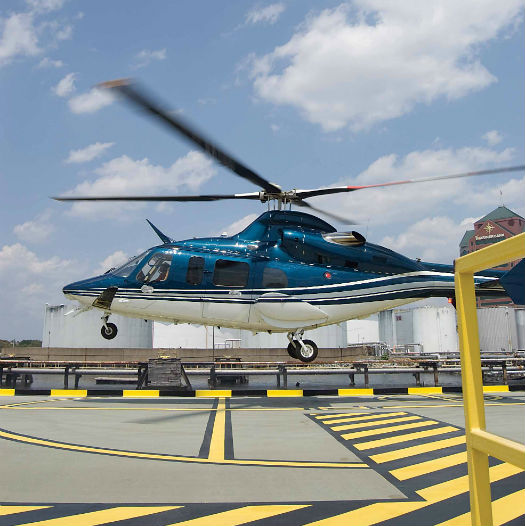
A Bell 430 serves ownership partners in Baltimore Marine Center as well as charter customers. GrandView Aviation Photos
As you climb away from the Pier 7 public use heliport in downtown Baltimore, Md., you get a spectacular view of the revitalization of the city’s historic Inner Harbor. A century ago, the Port of Baltimore was of the third largest port of entry for new immigrants to the United States. Today, the area is a magnet for the city’s residents and visitors alike, with an aquarium, science center, art museum, and upscale marinas, as well as a pedestrian promenade with eclectic shops and restaurants.
A major champion of the waterfront revitalization is Dan Naor, chief operating officer of Baltimore Marine Centers (BMC), which operates five upscale marinas in and around the Inner Harbor.
A former captain in the Israeli Navy, Naor is known locally as Baltimore’s “marina king” — but these days his real passion is aviation. As he transforms the waterfront with restaurants and green spaces, he is also nurturing the growth of three helicopter businesses based 5,000 miles apart in the United States and Israel.
The first of these is the Pier 7 Heliport, which is one of the few new downtown public use heliports in the United States.
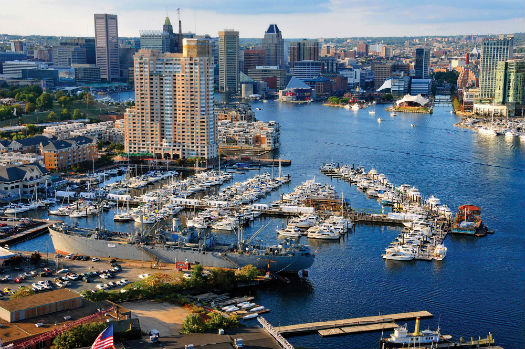
Baltimore Marine Center’s Harborview; harbor Marina is one of five operated by the company in the city’s inner harbour.
Then there’s GrandView Aviation (previously known as Baltimore Helicopter Services), which is a city-center based commercial helicopter operator providing executive transport in the Mid-Atlantic and Northeast states.
The final piece of the puzzle is Lahak Aviation — Israel’s first helicopter emergency medical service (HEMS) provider, and the only company flying to the offshore drilling platforms that are developing new gas fields in the Eastern Mediterranean.
Naor is recognized locally — and increasingly internationally — for his talent for spotting new business opportunities on the sea, and now in the sky.
“Pioneering new helicopter markets is very satisfying,” Naor told Vertical — and his customers, employees and business partners would probably agree.
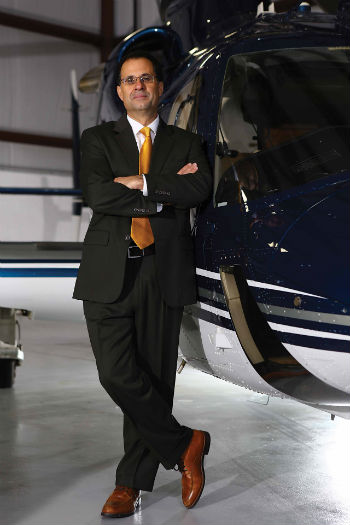
Dan Naor, COO of Baltimore Marine Center and GrandView Aviation. A former naval officer, his passion for boats and helicopters extends from the United States to Israel.
Marina Business
Born in Israel, Naor attended a naval high school academy and completed the grueling Israeli naval officers school (where creativity and improvisation are highly valued) before serving on submarines and commanding a coastal patrol boat guarding against terrorist infiltrations.
He left the navy at 26 and went traveling, eventually starting a new career in New York as the captain of yachts owned by wealthy families.
On his first voyage into Baltimore’s Inner Harbor in the early 1990s, Naor discovered a 16-acre waterfront industrial property at Lighthouse Point that he was convinced would be a great site for a new downtown marina.
The budding entrepreneur formed an investment group to buy the property in 1994 and over the next few years transform it into an upscale marina surrounded by 200 residential condominiums, 50 luxury homes, offices, retail shops, marine suppliers, restaurants, a health club and a pool.
The Lighthouse Point property launched BMC, which develops commercial and residential properties, restaurants and marinas catering to “city boaters” and transient visitors requiring moorage, fuel and meals.
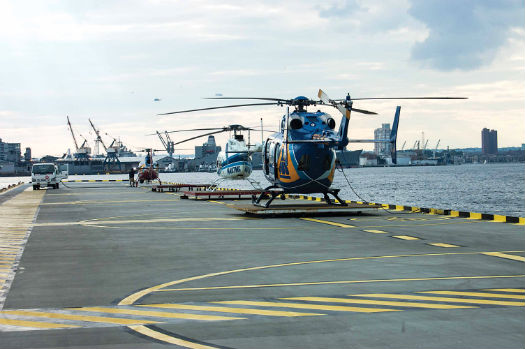
Pier 7 heliport is home base for John Hopkins Hospital’s EC145. Regular visitors also include helicopters from a local TV station,and law enforcement and public service agencies.
Sea to Sky
In the summer of 1998, BMC hosted a big league boat race by the American Power Boat Association that saw 45-foot long boats capable of going more than 130 miles per hour racing around a five-mile oval course.
The six race teams had helicopters ready to carry rescue divers in case of a boating emergency. The helicopters were operated from BMC’s marina property. “I went for a flight in a [Aerospatiale SA341G] Gazelle and that experience changed everything for me,” recalled Naor. “I fell in love with flying helicopters and also brought my passion for helicopters into our business.”
The partners in BMC soon became regular helicopter charter customers, and, in August 2004, the company made the leap of establishing its own corporate flight department, with a Bell 430 at Martin State Airport.
“One of the biggest advantages of adding the helicopter was that we could fly between downtown Baltimore to New York City in about one hour,” said Naor.
Chief pilot David Bezos said most of the flights supported the company’s marina and commercial real estate businesses, which at the time included a marina development on Long Island, N.Y. “We used a 50-foot-square floating pier in one of our marinas to pick up passengers in the harbor, and this generated a lot of interest from other helicopter operators wanting downtown access,” he said.
The Bell 430 proved itself, but it was sold after eight months of operation. “We received a purchase offer we couldn’t refuse,” said Naor.

GrandView Aviation’s Bell 430 and Bell 407s are based in a hangar at Pier 7, a five-minute drive from downtown Baltimore.
New Helicopter Businesses
Their experience with the Bell 430 had convinced Naor and his partners that operating helicopters could be a viable business in Baltimore — and perhaps Israel.
“In 2005, our business in the U.S. was doing well, so I decided to see what kinds of business opportunities I could find in Israel,” said Naor. “My partners wanted to do something that was good for Israel and knew that the country needed a helicopter emergency medical service. We learned that a new helicopter company had been created to develop an EMS service and they invited us to be a silent partners.”
Meanwhile, back in Baltimore, the marina partners decided to buy a Bell 407 and operate it as a business — Baltimore Helicopter Services (BHS) — under a Federal Aviation Regulations part 135 charter certificate.
“From the beginning, we knew we needed access to downtown Baltimore and we were very fortunate to already own a 600-foot long pier that we knew would make a fantastic heliport,” said Naor.
Just inside the harbor, about a five-minute drive from downtown Baltimore, the BMC Boatel on South Clinton Street contained a marina, a four-acre yard for servicing and storing boats, and Pier 7 — a dock used to unload ships.
“Our goal was to establish a heliport with a hangar to store and maintain our own helicopters and sell fuel to visitors,” said Bezos.
The company found the process of getting approval from the city to rezone Pier 7 as a heliport relatively straightforward; the dock was in an industrial area and there was no opposition to the plan.
The Baltimore Helicopter Services Pier 7 heliport opened as a private facility in spring 2006, and the first tenant was a Eurocopter EC145 operated for John Hopkins Hospital by Stat MedEvac. Relocating the aircraft to the downtown heliport improved emergency response times since the heliport had Jet A fuel on site, and was only a one-minute flight from the hospital.

GrandView Aviation sees its key benefit as being able to get customers as close to their destination as possible. “We try to avoid using airports since it deflects the utility of a helicopter,” said chief pilot David Bezos. “Our goal, whenever possible, is to land on the property that is the end destination of the flight — so we work hard to get the landowner’s permission.”
From Private to Public
For decades, the densely populated region from Washington, D.C. to Boston, Mass., has been the focus of numerous heliport development studies, but very few public use heliports have opened in the corridor over the past 30 years. This is what makes development of the Pier 7 heliport — and its strong community support — such a remarkable success story.
As it happened, the development of the heliport coincided with the publication of a Maryland-Metropolitan Washington Regional Helicopter System Plan.
“The Maryland Aviation Administration [MAA] provided us with tremendous support to transform the Pier 7 heliport into a public use facility,” said Naor. “They funded 90 percent the cost of an economic study into its business impact, and provided financial assistance under the Maryland Assistance to Private Airports program to improve the landing pads, navigation aids and other safety features over several years.”
The heliport was improved with state funding and became a public use (but privately-owned) facility in 2008, with six 44-foot diameter parking spots extending from the shore (sized to accommodate a Sikorsky S-76), and a 45-foot square “H” at the end of the 600-foot dock that’s used for all approaches and departures.
In 2012, the heliport added a DigiWxTM Automated Weather Observation System (AWOS), providing real-time wind speed, wind direction, temperature, relative humidity, dew point, altimeter, visibility and cloud height on a graphical display, over a VHF frequency, and on the Internet.
A 2012 MAA economic impact study found that the Pier 7 heliport generated $2.1 million in business revenue; 39 direct, indirect and induced jobs; personal income of $1.9 million, and $194,000 in state and local taxes.
Over the past nine years, the heliport has become a gateway for professional entertainers and athletes heading to downtown venues. In addition to VIP guests, frequent visitors now include EMS helicopters dropping off patients at Baltimore area hospitals (the heliport is a weather alternate), news helicopters operated by local TV stations WJZ-13 and WBAL-11, and local and state law enforcement.
The first hour of parking at the heliport is free, with landing and parking fees (up to three hours) ranging from $35 to $150 (for Bell 206Bs through Sikorsky S-92s) waved with fuel purchases of 50 gallons or more.
With an average of 20 helicopter refuelings a day, fuel sales provide important revenue for the heliport, but Bowling said it was priced to be competitive with local airports.

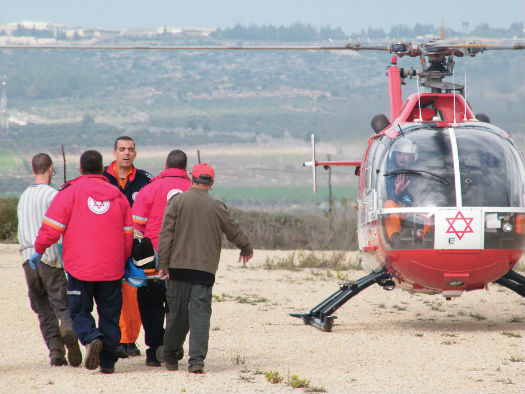
Naor’s investment group also operates Lahak Aviation, a helicopter emergency medical service in Israel that uses MBB Bo.105s.
Charter Service
BMC’s first Bell 407 re-launched the company’s corporate helicopter operations in 2007 from a brand new 7,000-square-foot hangar at Pier 7. It was a tough time to launch a charter service. Demand was flat until 2009 due to the global financial crisis, but demand has increased steadily since 2010.
“Dan and his business partners know a lot of people and we started to get more word of mouth business and charters from our marina patrons,” said Bezos. “The longer you are in the market, the more the business seems to grow.”
Charter sales increased by 65 percent over 2011 prompting BHS to add its second helicopter, a six-seat Bell 430 in August 2012.
“We acquired the Bell 430 to serve Fortune 500 companies and other clients that prefer a twin-engine helicopter — and for missions that require a faster and larger capacity helicopter,” said Jessica Bowling, the company’s director of sales and marketing.
According to Bowling, growth continued through 2012 as a result of a better economy and aggressive marketing.
“Our marketing strategy focuses on the needs and desires of ultra-high net worth individuals and executives,” she said. “These consumers and their brokers are used to twin-engine, dual pilot fixed-wing services with safety management systems; we put our energy into meeting these requirements and educating clients on the unique abilities of helicopters.
“I think it’s vital that helicopter charter operators keep an eye on trends in the fixed-wing and other luxury industries; the standards set by other luxury service providers are expected in our services as well.”
Earlier this year, the company replaced two early model Bell 407s with a newer 407, and as Vertical went to press was awaiting Federal Aviation Administration instrument flight rules approval for its Bell 430 to enhance flight safety in marginal weather. An order has also been placed for a new Bell 505 JetRanger X “to serve clients who don’t require the 407s speed and capacity,” said Bowling.
All of GrandView’s helicopters are equipped with Skytrac’s satellite-based flight tracking system, with charter clients able to access Skyweb (a password protected web site) to monitor flights and schedule timely ground transportation at either end of a flight.

Pier 7 Heliport opened as a private facility in spring 2006, and is one of few to have opened in the last 30 years in the corridor between Washington, D.C., and Boston, Mass.
With an eye to expanding the geographic scope of its business, the helicopter charter business recently rebranded — becoming GrandView Aviation in September this year.
“Our helicopters serve clients in the Mid-Atlantic region, from New York to Washington, D.C., and beyond — and we believed it was time to have a corporate brand that wasn’t as Baltimore-specific,” said Bowling.
New York City is the most popular destination for charter clients, with the company able to land at any one of three heliports in Manhattan.
“If you are a business executive traveling from Baltimore to a meeting in New York City with two lawyers, it can get pretty expensive if you travel by train or airline,” said Naor. “We can do the trip in 60 to 70 minutes by helicopter.”
Other popular charter destinations include Atlantic City and Maryland’s Eastern Shore, which can take up to three hours to reach by car, depending on traffic — or 20 minutes by helicopter.
“We try to avoid using airports since it deflects the utility of a helicopter,” said Bezos. “Our goal, whenever possible, is to land on the property that is the end destination of the flight — so we work hard to get the landowner’s permission.”
GrandView keeps its operating costs low by owning its helicopters, hangar, heliport and Jet A fuel supply. The low cost base has allowed it to price its services to meet the market and charge less for charters than its competitors in New York, said Naor.
Most helicopter companies avoid disclosing their charter rates, but GrandView is an exception. Rates for the Bell 407 ($1,900 per hour) and Bell 430 ($3,500 per hour) are posted on its web site for all to see.
Frequent fliers enrolling in the GrandView Helocard 50 ($50,000) or Helicard 100 ($100,000) can lock in rates for two years and receive a $100 per hour discount. Wait fees are also cut or waved.
The company also does its part for charity. Several times a month, GrandView helicopters take off on donor organ retrieval missions with a surgical team. These flights are on behalf of the Living Legacy Foundation, a Maryland-based nonprofit organization that is dedicated to organ and tissue procurement throughout the state.
The flights were the idea of Guy Barber, a partner in the helicopter business and a former flight paramedic. Barber believed passenger helicopters were better suited for organ retrieval missions than often-cramped EMS helicopters. He pitched his idea to the other partners in BHS (most of whom are doctors), and the humanitarian service took flight.

GrandView Aviation renewed its Bell 407 fleet in 2014 with two newer models.
Capital Market
Washington, D.C., was once a large helicopter charter market in its own right, but the changes to airspace regulations that followed the 9/11 terrorist attacks pushed charter operators to the periphery of the city.
In 2012, GrandView received approval to fly charters into Ronald Reagan Washington National Airport (DCA) under the DCA Access Security Program (DAASP), which required a stop at an approved FBO at a gateway airport.
Then, in the summer of 2013, Pier 7 became the first heliport in the U.S. to be approved as a gateway or authorized last point of departure for DASSP operations to Reagan airport after the facility received Fixed Base Operator Standard Security Program (FBOSSP) approval from the Transportation Security Administration (TSA).
“We had to jump through a lot of hoops with the TSA to meet their requirements,” said Bezos. Security provisions include pilot background checks, pre-screening of passengers and bags by TSA officers at Pier 7, and a requirement to carry a law enforcement officer on every DCA flight. The security provisions add to charter fees, but GrandView recently trained its own air marshal to replace a contractor.
GrandView is also working to support efforts by U.S. Congresswoman Eleanor Holmes Norton (D-DC) to allow for the South Capitol Street Heliport in Washington, D.C., to reopen to civilian helicopters, in addition to law enforcement, military and medical evacuation flights.
Many of the early immigrants that passed through the Port of Baltimore went on establish successful businesses throughout the United States.
A century later, a fellow immigrant — who also arrived by sea — launched a business that re-energized that same historic district, and then he found a whole new passion in the world of vertical-lift aircraft. Given how dramatically Dan Naor has changed the landscape of Baltimore on the waterfront and in the air in such a short space of time, it’s exciting to think what may still lie in story for the world of aviation in the Mid-Atlantic region.





